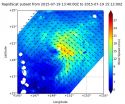INFORMATION:
About HPTN Study 052
HPTN 052 is a randomized, controlled trial designed to evaluate the effectiveness of antiretroviral therapy to prevent the sexual transmission of HIV in serodiscordant couples. The trial was conducted by the HIV Prevention Trials Network (HPTN) and funded by the National Institute for Allergy and Infectious Diseases (NIAID) at the US National Institutes of Health (NIH). Additional support was provided by the NIAID-funded Adult Clinical Trials Group. The antiretroviral drugs used in the study were made available by Abbott Laboratories; Boehringer Ingelheim Pharmaceuticals, Inc.; Bristol-Myers Squibb; Gilead Sciences; GlaxoSmithKline; and Merck & Co., Inc.
About HPTN
The HIV Prevention Trials Network (HPTN) is a worldwide collaborative clinical trials network that brings together investigators, ethicists, community and other partners to develop and test the safety and efficacy of interventions designed to prevent the acquisition and transmission of HIV. HPTN studies evaluate new HIV prevention interventions and strategies in populations and geographical regions that bear a disproportionate burden of infection. The HPTN research agenda is focused primarily on the use of integrated strategies: use of antiretroviral drugs (antiretroviral therapy and pre-exposure prophylaxis); interventions for substance abuse, particularly injection drug use; behavioral risk reduction interventions and structural interventions. For more information, visit http://www.hptn.org.
References:
M Cohen, et al. Final results of the HPTN 052 randomized controlled trial: antiretroviral therapy prevents HIV transmission. Program number MOAC0106LB, Track C.
SH Eshleman, et al. Treatment as prevention: characterization of partner infections in the HIV Prevention Trials Network 052 trial. Program number MOAC0106LB, Track C.
J Fogel, et al. Identification of factors associated with viral suppression and treatment failure when antiretroviral therapy is used for HIV prevention: results from the HIV Prevention Trials Network (HPTN 052) trial. Program number MOPEC417, Track C.
D Sabin, et al. Analysis of HIV drug resistance in adults receiving early antiretroviral treatment for HIV prevention: results from the HIV Prevention Trials Network (HPTN 052) trial. Program number TUPEB285, Track B.
HPTN 052 demonstrates sustained benefit of early antiretroviral therapy
2015-07-20
(Press-News.org) VANCOUVER, B.C. and DURHAM, N.C. - Antiretroviral therapy (ART) for HIV infection provides lasting protection against the sexual transmission of the virus from infected men and women to their HIV-uninfected sexual partners, investigators from the HIV Prevention Trials Network (HPTN) reported today at the 8th International AIDS Society (IAS) Conference on HIV Pathogenesis, Treatment and Prevention in Vancouver, Canada.
The study, known as HPTN 052, began in 2005 and enrolled 1,763 HIV sero-discordant couples - where one person is HIV-infected and the other is not - at 13 sites in nine countries. The majority of the couples were heterosexual (97%). HIV-infected partners were assigned to start ART at the beginning of the study, called the "early" arm, or later in the study, called the "delayed" arm. Those on the delayed arm started ART when their bodies' immune systems were declining. HPTN 052 was funded primarily by The National Institute of Allergy and Infectious Diseases, part of the National Institutes of Health.
"These findings demonstrate that antiretroviral therapy, when taken until viral suppression is achieved and sustained, is a highly effective, durable intervention for HIV prevention," said Myron Cohen, M.D., director of the Institute for Global Health and Infectious Diseases at the University of North Carolina at Chapel Hill and principal investigator for HPTN 052. "The HPTN 052 trial was designed to address two questions: whether providing antiretroviral therapy to an HIV-infected person would prevent HIV transmission to a sexual partner, and whether earlier antiretroviral therapy offered long-lasting health benefits, and the answer to both is a resounding yes."
In 2011, an interim review of the study data showed a 96% reduction of HIV transmission within the couples assigned to early ART, which was considered a major breakthrough finding. After the release of the results, all participants in the delayed ART arm were offered the opportunity to begin ART, and the study continued for four more years. By the end of the study, 1,171 couples remained in follow-up.
As reported today, the final results show a sustained 93% reduction of HIV transmission within couples when the HIV-infected partner was taking ART as prescribed and viral load was suppressed. Notably, there were only eight cases of HIV transmission within couples after the HIV-infected partner was given ART. However, four of these eight cases were diagnosed soon after ART initiation and transmission likely occurred before the HIV infected partner was virally suppressed. The other four were diagnosed when the HIV-infected partner had detectable levels of virus in the blood despite being on ART (treatment failure). Treatment failure may have occurred because participants either did not take their antiretroviral drugs as prescribed or had an HIV strain that resisted or acquired resistance to one or more of the drugs in their treatment regimen.
HPTN 052 investigators are also reporting findings at the IAS conference concerning the relationship between viral load, viral suppression, treatment failure and drug resistance. Investigators found that having a relatively high level of HIV in the blood at the start of treatment was associated with a longer time to viral suppression, which, in turn, was associated with both treatment failure and a shorter time to treatment failure. In addition, the investigators found, among the HPTN 052 participants who failed treatment, those who had a higher viral load when they joined the study were more likely to develop resistance to their antiretroviral drugs. More research is needed to understand this association, according to the investigators.
"These results have important implications for programs seeking to combine other HIV prevention measures with treatment as prevention," Dr. Cohen said. "In the setting of such programs, special efforts should be made to minimize HIV transmission risk before viral suppression has been achieved, to maintain suppression on ART, and to identify and address ART failure."
ELSE PRESS RELEASES FROM THIS DATE:
For kids with injured ankles, less treatment may be more
2015-07-20
WASHINGTON --Emergency physicians can safely reduce x-rays in children with hurt ankles by as much as 23 percent and save emergency patients both money and time. The results of a cost analysis of the Low Risk Ankle Rule (LRAR) were published online Tuesday in Annals of Emergency Medicine "Cost Consequence Analysis of Implementing the Low Risk Ankle Rule in Emergency Departments".
"Currently, x-rays are ordered for up to 95 percent of children who come to emergency departments with ankle injuries, though only 12 percent of those x-rays show fractures," said lead study ...
Perovskite solar technology shows quick energy returns
2015-07-20
Solar panels are an investment -- not only in terms of money, but also energy. It takes energy to mine, process and purify raw materials, and then to manufacture and install the final product.
Silicon-based panels, which dominate the market for solar power, usually need about two years to return this energy investment. But for technology made with perovskites -- a class of materials causing quite a buzz in the solar research community -- the energy payback time could be as quick as two to three months.
By this metric, perovskite modules are better than any solar technology ...
Satellite data shows Tropical Cyclone Halola getting stronger
2015-07-20
Tropical Depression Halola is getting stronger. NASA data pinpointed the area of strongest sustained winds on July 19 and the extent of those winds expanded on July 20 as Halola became a tropical storm again. NASA also gathered infrared data that showed cloud top temperatures getting colder, indicating more uplift or strength in the storm.
On July 19 at 2 p.m. GMT (10 a.m. EDT), the RapidScat instrument aboard the International Space Station gathered data on surface winds in Tropical Depression Halola. RapidScat saw the strongest sustained winds were on the northeastern ...
HIV control through treatment durably prevents heterosexual transmission of virus
2015-07-20
Antiretroviral treatment that consistently suppresses HIV is highly effective at preventing sexual transmission of the virus in heterosexual couples where one person is HIV-infected and the other is not, investigators report today at the 8th International AIDS Society Conference on HIV Pathogenesis, Treatment & Prevention (IAS 2015) in Vancouver, Canada. The finding comes from the decade-long HPTN 052 clinical trial funded primarily by the National Institute of Allergy and Infectious Diseases (NIAID), part of the National Institutes of Health, and conducted by the NIH-funded ...
Novel glycoengineering technology gives qualitative leap for biologics drug research
2015-07-20
Researchers from the University of Copenhagen have discovered a way of improving biotech drugs. Better, cheaper and more effective drugs to combat cancer, arthritis and many other disorders.
This is the result of a ground-breaking new technique developed by a group of researchers from the Faculty of Health and Medical Sciences at the University of Copenhagen.
The method can improve a large number of so-called glycoprotein-based pharmaceuticals used to treat a variety of diseases. The technique has recently been described in one of the world's most distinguished scientific ...
Adolescent friendship study confirms 'birds of a feather flock together -- stay together'
2015-07-20
No one likes to lose a friend, especially adolescents. But why do friendships end? Researchers in the Charles E. Schmidt College of Science at Florida Atlantic University sought to answer this question with a study examining whether adolescent friendships end because of undesirable characteristics of friends, because of differences between friends, or both. Findings from this long-term longitudinal study of 410 adolescents involved in 573 friendships are published in the current issue of Psychological Science.
Adolescent friendships are fleeting. The majority dissolve ...
The chemistry of wine (video)
2015-07-20
WASHINGTON, July 20, 2015 -- If you're stumped in the wine aisle of the store, then you're not alone. Every bottle has unique nuances of taste and smell. How can something made of grapes smell buttery or taste like grass? Learn about the complex chemistry behind wine and then impress your friends at your next party thanks to Reactions. Check out our wine chemistry primer here: http://youtu.be/_UaS743_aEs.
Subscribe to the series at http://bit.ly/ACSReactions, and follow us on Twitter @ACSreactions to be the first to see our latest videos.
INFORMATION:
The American ...
Life-saving breast cancer drugs going untaken in Appalachia
2015-07-20
Nearly a third of breast cancer survivors in Appalachia are not taking the critical, potentially life-saving follow-up treatment - despite having insurance that would pay for it, a troubling new study has found.
Researchers cross-examined cancer registries with Medicare claims data and determined that of 428 women, approximately 30 percent failed to follow through with their prescribed adjuvant hormone therapy, a treatment to prevent the cancer's recurrence.
"Almost a third of the prescriptions for adjuvant hormone therapy were not filled, which is much, much higher ...
Georgia State study finds state regulations linked to late cancer diagnoses
2015-07-20
ATLANTA--States' regulations of health insurance and practitioners significantly influence when patients receive colorectal or breast cancer diagnoses, especially among people younger than the Medicare-eligible age of 65, according to a new study by researchers at Georgia State University's School of Public Health and the University of North Carolina at Chapel Hill.
The study suggests that where people live is a strong predictor of whether they will receive potentially life-saving cancer screenings.
Dr. Lee Rivers Mobley, associate professor of spatial science and health ...
Ocean acidification may cause dramatic changes to phytoplankton
2015-07-20
Oceans have absorbed up to 30 percent of human-made carbon dioxide around the world, storing dissolved carbon for hundreds of years. As the uptake of carbon dioxide has increased in the last century, so has the acidity of oceans worldwide. Since pre-industrial times, the pH of the oceans has dropped from an average of 8.2 to 8.1 today. Projections of climate change estimate that by the year 2100, this number will drop further, to around 7.8 -- significantly lower than any levels seen in open ocean marine communities today.
Now a team of researchers from MIT, the University ...

